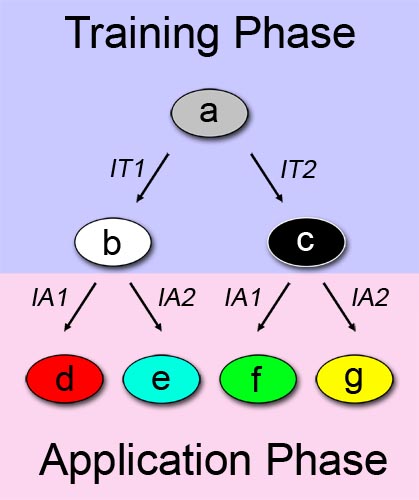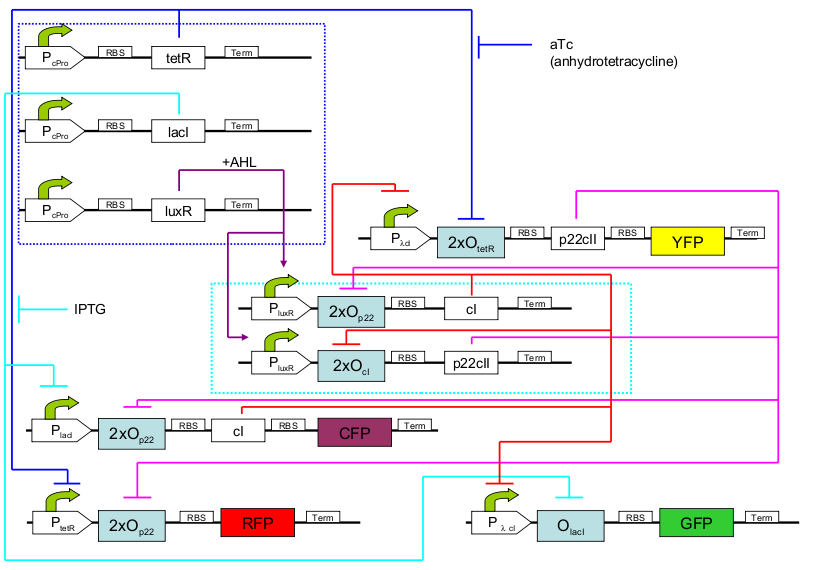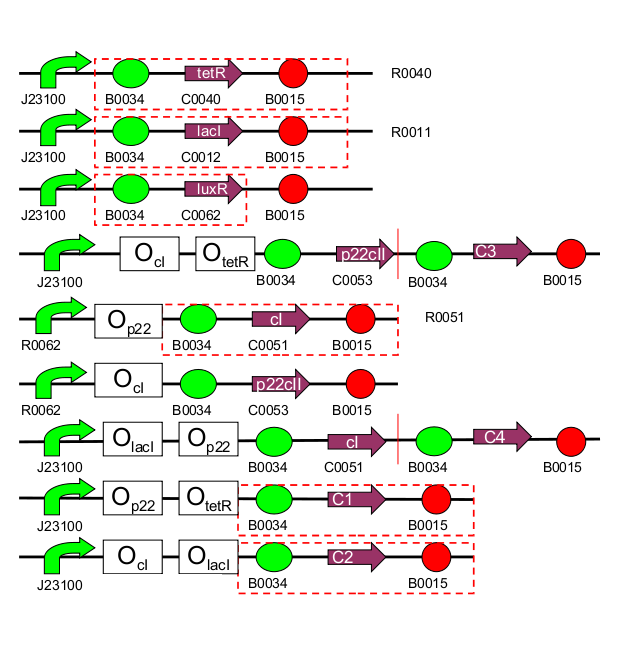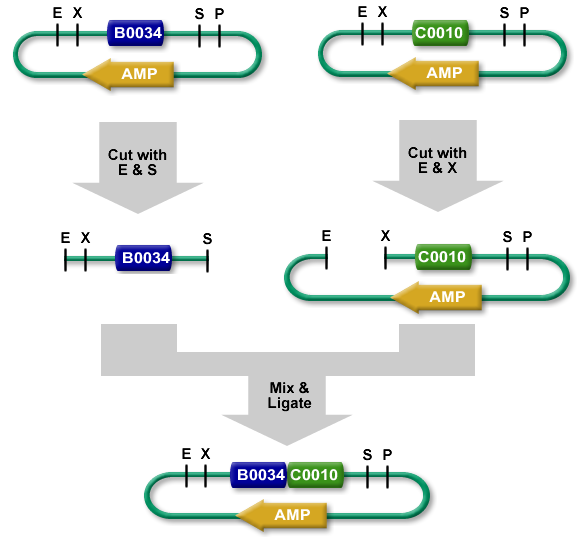ETHZ/Biology
From 2007.igem.org

.:: Introduction ::.
Our aim is to engineer a biological model system which exhibits [http://en.wikipedia.org/wiki/Learning learning ability] and can also work according to [http://en.wikipedia.org/wiki/Divergent_evolution the mechanism of divergent evolution], i.e. a system which can alter its behavior according to external stimuli. We are interested in such a system, since learning and adaptation are playing major roles in living organisms and machine learning has numerous applications in engineering - it is therefore a fantastic interface between engineering and biology. Possible applications are as exciting as biological memories or self-adaptative systems.
.:: A Biological Multiple State Automaton ::.
A straightforward approach on how to describe learning behavior and adaptive evolution, can be see in Figure 1. We can separate the process in two phases: a training or learning phase (shown in blue), and an application or "real world" phase (shown in pink), and describe our system as a multiple state automaton. The examined system can alter its state according to a certain input/stimuli that it was exposed to in the first phase. In this binary example, the system changes its state from a to b when it is exposed to a first training-phase-input (IT1). Similarly, the system changes its state from a to c when the other training-phase-input (IT2) is applied.
The principle described above is also valid in the application phase. In the application phase, we have two possibilities for initial system state. Thus, the automaton expands with four more states. Depending on which state the system is at the start of the application phase, and which chemical it is exposed to, it reaches a different final state. State d is reached if the first out of two possible application-phase-inputs (IA1) is applied while the system is at state b. In the end, we can differentiate between the possibilities of the system being trained with one chemical, and being exposed to a different chemical in the application phase. Since we have two different training chemicals, and two different application chemicals, we reach the final number of four states.
In the following, we elaborate on the two stages of our system:
- How can we describe learning ability with this approach?
Define the training-phase-inputs themselves as the information entities to be learned. This implies that after the training phase, the information is permanently stored in the system - a memory has been created. According to its memory, the system will behave differently when it is exposed to a certain stimuli in a later stage. - The automaton of Fig. 1, presents similarities to family trees, or [http://en.wikipedia.org/wiki/Phylogenetic_tree phylogenetic trees]. According to different external stimuli, the initial population divides, and evolves into different species. The proposed automaton model can be used to explain the concepts of peripatric speciation, parapatric speciation, sympatric speciation or artificial speciation e.t.c. However, the most imporant fact, and what has stimulated our research in the area, is to create a biological system that can evolve without changing its DNA content over time.
.:: Detailed System ::.
In our project we are constructing an E. coli strain which with the help of an external chemical signal (AHL) is able to remember which of the two chemical substances (aTc and IPTG) it has previously been exposed to. The system architecture is based on a toggle switch consisting of different repressor and activator proteins synthesized from promoters which subject to two different regulations.</p>
In the first operation phase (learning), the system is exposed to one of the two chemicals (aTC and IPTG) and AHL is added, causing a steady system behavior. In the second phase (remembering), the chemicals are removed, but AHL allows the system to still maintain its state.
Finally, in the final phase (recognition), the system is exposed to any of the two chemicals again. Its response, reported with 4 fluorescent proteins, differs according not only to which chemical the system is exposed to now, but also to if this chemical is the same that the system has already experienced (learning effect). Therefore, 4 possible system responses are possible: now exposed to aTc and have seen it before/ now exposed to aTc and have not seen it before/ now exposed to IPTG and have seen it before/ now exposed to IPTG and have not seen it before.The systems consists of 11 parts that can be synthesized independently:
| 1 | [http://partsregistry.org/Part:BBa_I739001 TetR production] (constitutive part of system) |
|---|---|
| 2 | [http://partsregistry.org/Part:BBa_I739002 LacI production] (constitutive part of system) |
| 3 | [http://partsregistry.org/Part:BBa_I739003 LuxR production] (constitutive part of system) |
| 4 | 1st half of p22/YFP production (outer part of system, reporting) |
| 5 | 2nd half of p22/YFP production (outer part of system, reporting) |
| 6 | CI production (inner part of system) |
| 7 | p22 production (inner part of system) |
| 8 | 1st half of CI/CFP production (outer part of system, reporting) |
| 9 | 2nd half of CI/CFP production (outer part of system, reporting) |
| 10 | RFP production (reporting) |
| 11 | GFP production (reporting) |
Three plasmids are used to house the above DNA parts, as can be seen from the following table:
| plasmid | resistance | copy type | contents | comments |
|---|---|---|---|---|
| pbr322 | ampicillin | medium | 1,2,3 | constitutive part |
| pck01 | chloramphenicol | low | 4,5,8,9 | outer part |
| pacyc177 | kanamycin | low | 6,7,10,11 | inner part, reporting |
.:: Experiments ::.
.:: References ::.
[1] Standard Assembly Process, http://partsregistry.org/Assembly:Standard_assembly
.:: To Do ::.
- Katerina: 1. Number system parts on both figures for easier reference.
- Katerina: 2. Add more info on all system parts and link to the ones existing in the registry. Write info on the ones that didn't exist in the registry (with detailed info such as addition of bp's as Christian and Sven had done).
- Katerina: 3. Add cloning plan. (Christos: Maybe the details will be at the team note's?)
- Christos: 1. The picture with the abstraction - maybe we can put better names on the arrows.
- Christos: 2. We can make figure 1 more specific. Instead of having IT and IA, we can have Chemical 1, Chemical 2, and then again. I think it will be more obvious like that.
- Christos: 3. Nice descriptions Stefan. However, I made the text less, and kept the original idea, since I felt like it was moving away from the purpose, which is a simple introduction and clarification of concepts. I also removed the pictures. I have backups of everything, so, we can put it back if the others disagree.



